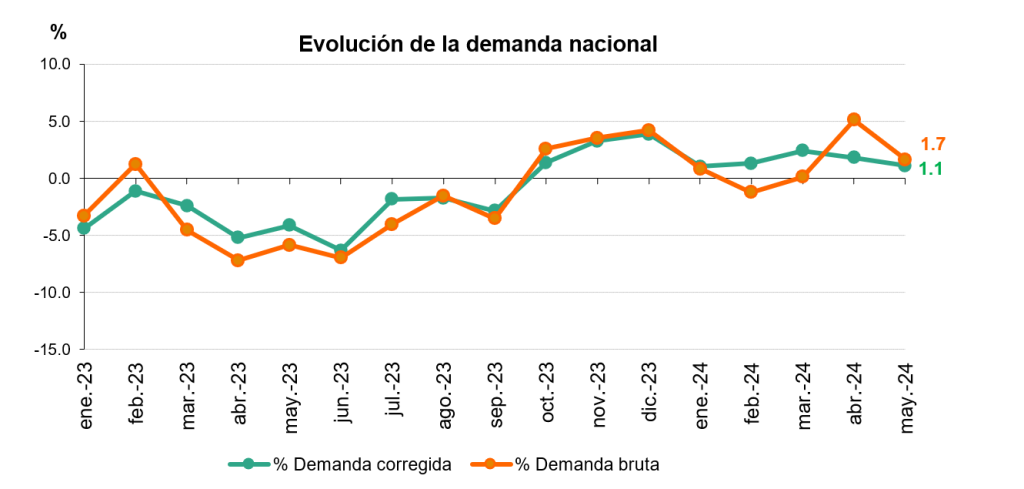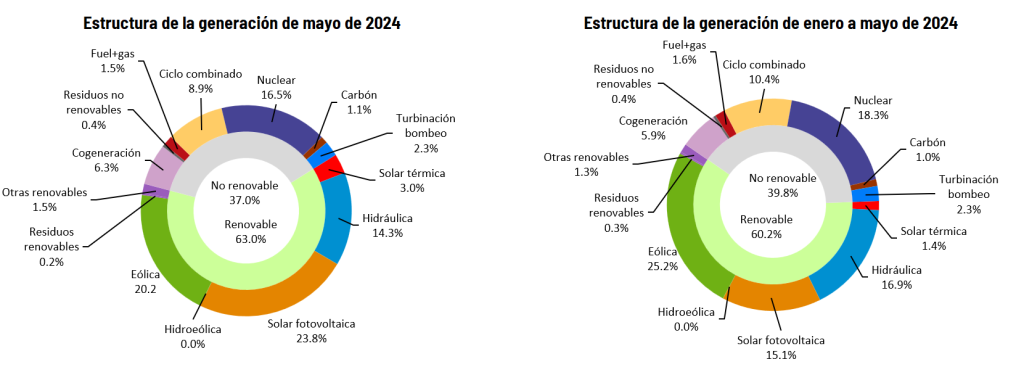Monthly production with renewables in our country represented 63% and technologies that do not emit CO2 equivalent reached a share of 81.4%: wind contributed 20.2% and photovoltaic 23.8%.
The demand for electrical energy in Spain increases 1.1% in May. Electricity demand grows by 3.8% in the Balearic Islands and 2.8% in the Canary Islands, once the effects of work hours and temperatures are taken into account.
National electricity demand experienced an increase of 1.1% in May compared to the same month of the previous year, once the effects of temperature and work hours were discounted. In gross terms, a demand of 19,432 GWh is estimated, 1.7% higher than that of May 2023.
In the first five months of 2024, Spain has registered a demand of 101,423 GWh, 1.2% more than in the same period of 2023.

This month, renewables generated 13,520 GWh, 16.4% more than in May 2023, and reached a share of the total of 63%, this being the first month in history in which solar photovoltaics leads the national mix. , with 23.8% of the total. During this month, this technology produced 5,098 GWh, a figure that represents an increase of 31.6% compared to May 2023, and thus becomes a historical maximum for both production and quota.

It should be noted that on May 24, solar photovoltaic broke its daily production record with 199 GWh, which represented a share of 29% of the total, the highest in its history in daily generation structure.
According to the provisional data available today, wind power is the second technology with the highest electricity production in May, with 20.2% of the total; followed by nuclear (16.5%) and hydraulics (14.3%).
With this boost from renewables, 81.4% of electricity
Peninsular demand increases 1%
At the peninsular level and once the effects of work and temperature have been taken into account, demand has been 1% higher than in May 2023. In gross terms, demand this month has been 18,198 GWh, 1.5% higher than that of the same month of the previous year.
In the first five months of the year, peninsular demand has been 95,493 GWh, 1.1% higher than that registered in 2023.
The total of peninsular renewables generated 65.2% of the total in May, according to provisional data available today, which shows a production of 13,261 GWh, 16.3% more than in the same month of the previous year. For their part, emission-free technologies contributed 84.6% of the total.
The peninsular generation structure in May is also led by photovoltaic solar, which has been responsible for 24.6% of the total, producing 5,007 GWh during this month.
The electrical system in the Balearic Islands and Canary Islands
In the Balearic Islands, electricity demand in May was 3.8% higher than in the same month of 2023, once the effects of work hours and temperatures are taken into account. Thus, gross demand is estimated at 482,454 MWh, 4.9% more than in May of the previous year. From January to May 2024, the Balearic gross demand is estimated at 2,194,167 MWh, 1.4% more than in the same period of 2023.
In terms of generation, the combined cycle, with 59.2% of the energy produced in the Balearic Islands, was the islands’ first source this month. For its part, renewable energy without CO2 equivalent emissions generated in the Balearic community represented 20% of the total, the largest share recorded in the archipelago. Balearic renewable production grew by 54.6% in May compared to the same month of the previous year.
Furthermore, the underwater link between the Peninsula and Mallorca contributed during this month to covering 24.4% of the Balearic electricity demand.
For its part, in the Canary archipelago, the demand for electrical energy grew by 2.8% compared to the same month in 2023, taking into account the effects of work and temperatures. In gross terms, demand was 719,502 MWh, 2.5% more. In the first five months of 2024, Canarian demand is estimated at 3,581,092 MWh, 3.5% more than in the same period of 2023.
Regarding electricity generation in the Canary Islands, the combined cycle, with 38.4% of the total, was also the first source in May. Renewables and emission-free technologies reached a share of 25.8% of production, with the wind contribution being 20.9%. This Canarian renewable production in May has grown by 12% compared to that registered in the same month of 2023.


